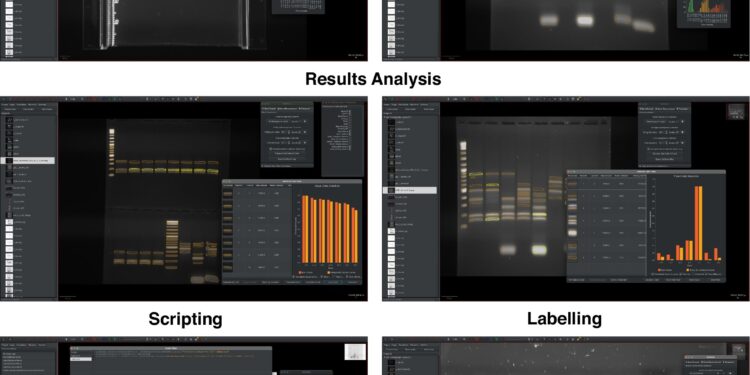Gelgenia in action. Credit: Nature communications (2025). DOI: 10.1038 / S41467-025-59189-0
Scientists at the University of Edinburgh have exploited the power of AI in a new tool that promises to accelerate the analysis of data from freezing electrophoresis experiences.
The technique is widely used through the biological sciences to separate and analyze biomolecules and systematically used to inform many biomolecule activities such as genomic manipulation, DNA super-coil or evaluation of the success or failure of the assembly of a bionanostructure or an artificial conjugate.
The central principle of electrophoresis on frost is simple: the biomolecules are suspended in the insert wells in a frost matrix, a tension is applied and the charged particles are pushed through the matrix. The size and load of different molecules make them move at different rates, which leads to a “band” barcode stretching from a well in a “track”. These models can be photographed and interpreted to provide qualitative and quantitative information on the content of a sample.
Despite the unprecedented progress in the processing of images in recent years, software methods for the analysis of freeze image have remained essentially unchanged for decades. Most, if not all, image analysis approaches involve a manual or semi-automatic process of digital sculpture and bands from an image before summarizing the intensity of pixels in each band. This process is tedious, subject to user error and is based on hypotheses that make the fight against bands difficult with irregular forms or curved trajectories.
However, by supervising the extraction and analysis of gel bands from an image as a task of AI, an automatic learning model can automate most of the tedious steps in the analysis process, while also eliminating biases and hypotheses inherent in manual approaches.
Evaluate the potential of segmentation as an approach to frost analysis. Credit: Nature communications (2025). DOI: 10.1038 / S41467-025-59189-0
The Edinburgh team began its project by creating an extensive data set of more than 500 human marked gel images with a range of common experimental scenarios. They used this data set to form a light neural network to precisely identify the bands from images.
The result was a very effective model capable of identifying the bands independently of their quality, their substantive intensity and even the presence of unexpected discontinuities such as torn pieces of gel. In addition, the approach was able to produce quantification results which corresponded or exceeded by those generated using conventional tools.
To allow others to apply the technique to their data, the team has also developed Gelgenie, an open source graphic application which allows users to extract gel images on their own devices, without knowledge or expert experience required.
The data set, the weights of the models and the script frame have also been published to allow others to use or refine models for more specialized applications or their own personalized pipelines.
Dr. Matthew Aquilina, who co-directed the project while he was at the University of Edinburgh, currently a postdoctoral researcher at Harvard University and Dana-Farber Cancer Institute, “to the best of our knowledge, Gelgenie is the first software platform to investigate with a universal gel analysis using others. Refinements and improvement of features.”
Dr. Katherine Dunn, University of Edinburgh, School of Engineering, who co-directed the project and supervised Dr. Aquilina, said: “Gel electrophoresis is widely used on the university and industry, but most scientists use relatively little sophisticated methods to analyze the analysis of electrophoresis on GELS.
The study is published in the journal Nature communications.
More information:
Matthew Aquilina et al, Gelgenie: a frame fueled by AI for the image analysis of electrophoresis on frost, Nature communications (2025). DOI: 10.1038 / S41467-025-59189-0
Supplied by the University of Edinburgh
Quote: AI eliminates the boredom of electrophoresis on frost with a quick and precise analysis (2025, May 5) recovered on May 5, 2025 from
This document is subject to copyright. In addition to any fair program for private or research purposes, no part can be reproduced without written authorization. The content is provided only for information purposes.



